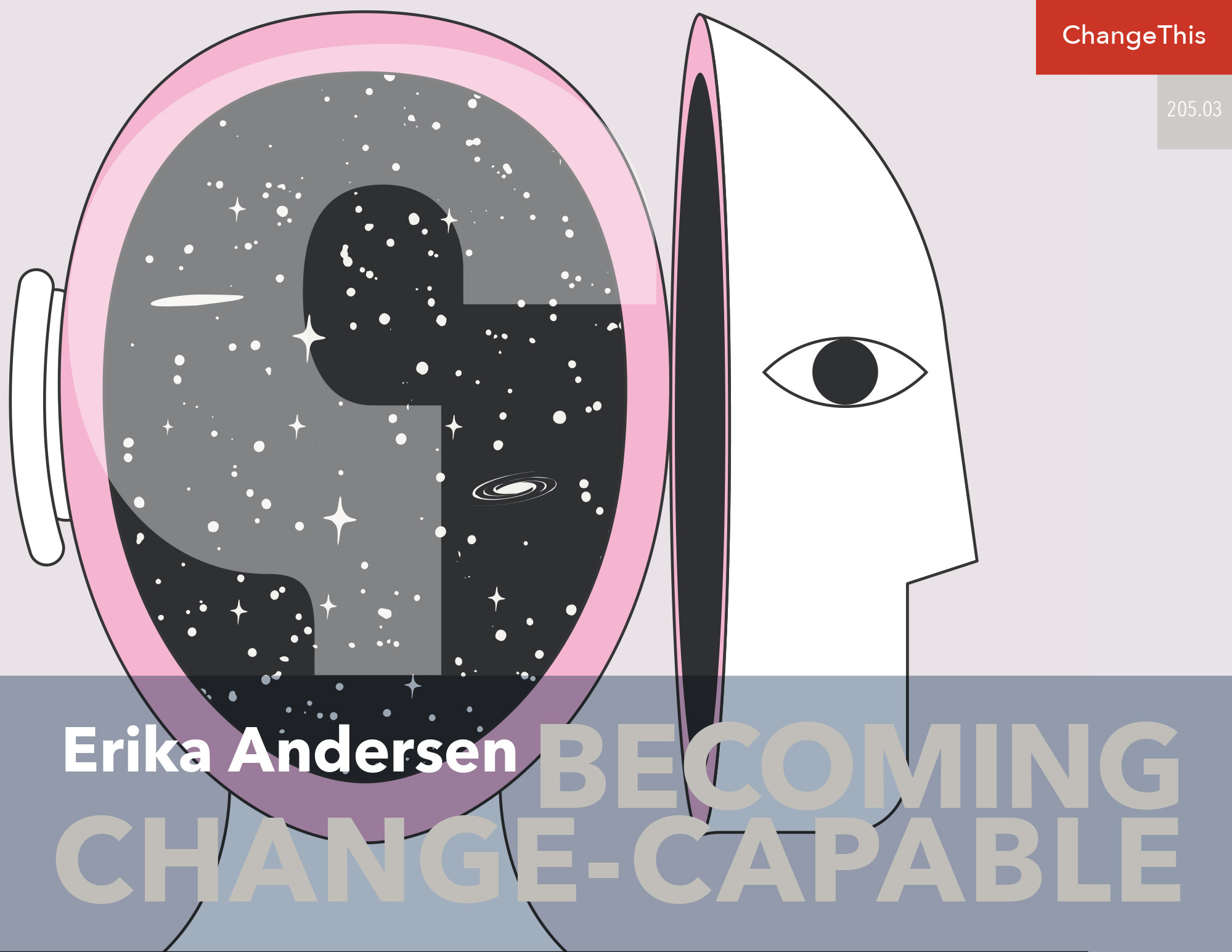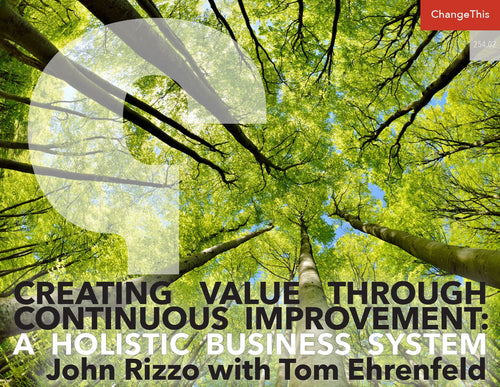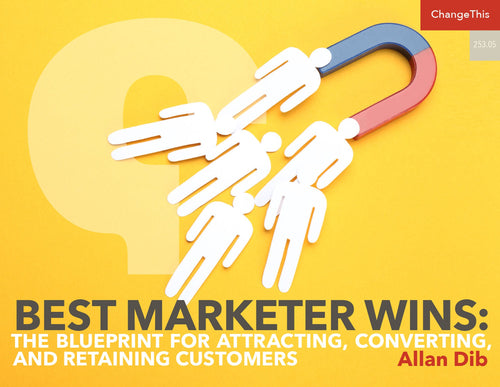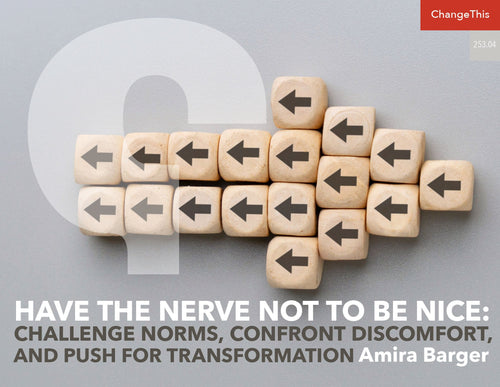Becoming Change-Capable
Unless you’ve been living on another planet, the past few years have shown that we’re in a time of unimagined, unrelenting, and ever-increasing change. And we’re not very good at it.
Over the past thirty years one-third of US manufacturing jobs—the mainstay of American advancement and job creation since the beginning of the twentieth century—have disappeared, gone the way of the dinosaur. Over the same time period, the demand for knowledge-and service-based jobs has doubled. In response to these shifts, thousands of companies that didn’t exist thirty years ago have come into existence, and in some cases grown exponentially (think Apple, Google, and Amazon). Thousands more have withered and died or dramatically transformed (think Barnes & Noble, any car company, and the entire music industry).
As an employee in an organization, all of this combines to feel like near-continuous change. A few decades ago, being part of an organizational redesign was a fairly uncommon phenomenon that we as employees had to suffer through: our organization would, in effect, get picked up, shaken, and set back down again, and—whew—that was it for a while. Now, there are changes big and small happening to us and around us on an almost daily basis: changes in who we report to, how our work gets done, what our jobs entail, and—more fundamentally—changes in who owns our company, what our mission is, what are the services or products we produce, who the customer is and what they expect from us.
This degree of change isn’t happening in just a few obvious industries like media or technology. A few years ago, I spoke to the annual convention of the global nonprofit Special Libraries Association, for professionals who work in and manage libraries of information specific to industries or knowledge areas. I made this same point about change—its magnitude and constancy in every area of our lives—and I asked everyone whose job had not changed at all in the preceding twelve months to raise his or her hand. Of the thousand or so people in the audience, maybe thirty put their hands in the air.
So, here we all are. Change—rapid, fundamental, and continuous—affects every aspect of our lives. Why am I telling you this? When I started my company in 1990, we named it Proteus, after the shape-shifting Greek sea-god whose mythology said that if you could find and hold on to him, no matter what form he assumed, he would be forced to reveal the future to you. We saw even then that the world was speeding up and changing dramatically, and that those shifts would call for new ways of responding. Understanding this, we defined our mission in this way: We help clients clarify and move toward their hoped-for future. Ever since, we’ve offered our services with that mission in mind; we’ve worked with clients to help them craft a clear vision of the future they want to create for themselves and to build the skills and knowledge necessary to move in that direction.
However, over the past decade we’ve seen that an ever larger part of helping our clients move toward their hoped-for future now involves helping them with change itself. This involves supporting our clients to understand how change works and how we can (and need to) rewire ourselves and our organizations to be able to create a successful future in an era of continuous and ever-expanding change.
OVERCOMING HOMEOSTASIS
Though the word homeostasis was coined less than a hundred years ago, it describes a phenomenon as old as humanity.1 For as long as we’ve been around, homeostasis—a kind of dynamic stability—has been essential to our well-being. For example, if we get too hot, we have bodily mechanisms like sweating to cool us back to an optimal temperature. And if those don’t work, we’ve learned to apply external balancers: move into the shade, find cool water to pour over ourselves and/or drink. If we get too cold, we put on more covering. Too low on fuel, we get hungry, and we eat. Humans are programmed to stay within a set of physical parameters that keep us alive and healthy, and that we experience as “comfortable.”
Historically, sociological homeostasis has also served us well. Being able to create and maintain stable family groups and larger working groups—village, farm, or factory—made it more likely that those groups would be able, over time, to prosper and grow. Doing our work in the same ways, cultivating and eating the same foods, having the same expectations of each other that had been shown to work well for many years, all of this was a good hedge against inevitable external disruption—crop failure, disease, invasion. As soon as the unusual circumstance was past, we learned to go back to “normal” as quickly as possible. In short: throughout the vast majority of human history, significant change was almost invariably a threat to our well-being and needed to be managed or removed immediately in order to return to homeostasis, the status quo.
This may sound like ancient history, but that preference for the status quo is very much with us today. Most modern-day “conservative” political movements, for instance, are primarily in favor of returning to what their adherents see as a healthier, safer homeostasis of the past: societal rules and expectations that “worked well” (at least for some people) for many years, and to which we should, adherents believe, return.
As a species and as individuals, we have been programmed for many thousands of years to believe that in order to survive, we have to define “normal” and then stay as close to that definition as we possibly can. This bias toward sameness and stability has in fact always been a powerful restraining influence on change. During the past few hundred years, as advances in communication and technology have been accelerating factors, our deeply wired-in preference for homeostasis has served as a consistent brake on that acceleration.
For example, in the mid-seventeenth century, scientists began to be able to see microorganisms under newly developed microscopes and began to posit these tiny creatures as a source of infection and disease. Over the next two hundred years, more and more scientific evidence supported this new “germ theory.”2 In the mid-nineteenth century, a doctor named Ignaz Semmelweis conducted an experiment. He made doctors wash their hands with chlorinated lime water before examining women giving birth. Over one year Semmelweis documented a sudden and dramatic reduction in the mortality rate of women attended in childbirth by these doctors—from 18 percent to 2.2 percent.3 But it was another fifty years before most doctors were regularly washing their hands between patients. Why? Because it was different from what they’d always done and what they assumed was best; it wasn’t “normal.” It seems they were uncomfortable accepting this new idea that implied that they—takers of the Hippocratic oath, those most knowledgeable about illnesses and their treatment—were actually making their patients sick, or even killing them.
If this single, seemingly simple change based on an ever-increasing body of data generated ongoing, entrenched negativity or dismissal for hundreds of years, it’s no wonder this age of continuous change makes us anxious! At work, for instance, just when we’ve figured out what’s “normal”—how things work, who is important, what the company does and why—it all shifts out from under us. Suddenly we’re reporting to someone new, the group next to us has been outsourced, our core work processes have changed, and the department goals have altered dramatically. And then, just as we’re starting to figure out this new normal, to accept it as the way things are and take a breath—everything changes again. It’s exhausting. It’s the way life is now, and it’s just going to keep speeding up.
So here we are with this deeply wired-in, ancient drive toward homeostasis. Instead of serving us almost all the time, as it has for millennia, this drive now only serves us some of the time. It serves us physiologically: it’s still important to keep our bodies within certain parameters of weight, temperature, and hydration to stay healthy and vital. The drive toward homeostasis often serves us interpersonally, too: it’s still healthy and important—maybe more than ever—to create and maintain strong, stable human bonds. But organizationally (and I would argue politically, scientifically, psychologically, and economically), we are going to have to let go of our age-old focus on keeping things the same and instead learn to feel comfortable with and to find a new kind of dynamic stability in a state of ongoing change. In order to survive and thrive today and tomorrow and next year, we need to rewire ourselves and our organizations. We need to create alternatives to our time-tested reliance on stability and the known—to build new ways of thinking and operating that will allow us to accept and even embrace continuous, multilevel change.
CHANGE FROM THE INSIDE OUT
When real change happens—in one human being or in an organization—it happens from the inside out. In other words, in order for someone to make a consistent change in his or her behavior, that person needs first to make a shift in his or her thinking. And in order to make real change in a whole organization, a critical mass of the people in that organization need to first shift their thinking.
Let’s go back to that huge change when doctors starting to wash their hands between patients. At the beginning of that transition, there were only a few doctors who thought that they could be transferring invisible creatures from patient to patient on their hands and thereby spreading disease. But those few did believe it. Their thinking changed—and that caused them to change their behavior. I can almost imagine the moment of change for an individual physician in the late nineteenth century: he reads a treatise by Louis Pasteur about germ theory, complete with illustrations of what the author has seen under his microscope, and thinks, “Hmm, maybe there’s something to this.” Then he continues reading and finds out about Semmelweis’s yearlong experiment with a small group of doctors consistently washing their hands before treating obstetrical patients—and reducing postpartum deaths from nearly one in ten women to about one in fifty. “Oh my god,” he thinks. “What if this is true?” And he reflects on all his patients who have died of puerperal fever in the past five years. He reads everything again; he talks to a fellow physician who is convinced this new theory has merit; he finally decides it’s likely to be true. He feels awful; he now believes he must change his habit. Then—and only then—he begins washing his hands between patients. Behavior change follows mindset change.
It still works that same way even when a behavior has become widely accepted—each individual only changes from the inside out. Statistics show that even now, 150 years later, many doctors don’t consistently wash their hands between patients. One large study found that hand washing rates were at just 26 percent in intensive care units, and 36 percent in the other wards (after monitoring systems were put in place in this study, that rate jumped to about 50 percent).4 Another study found doctors selfreported washing their hands 73 percent of the time but actually only did it 10 percent of the time.5 It sounds as though a lot of doctors still haven’t made that internal mental shift. They may wash their hands when somebody’s watching, or when it seems critical (in the operating room, for instance), but these studies show they’re just as likely to “forget” when they’re unobserved or they don’t think it is that important.6 A given doctor will wash his or her hands consistently when he or she personally believes it is a key contributor to patient health. Behavior change follows mindset change (Figure 1).
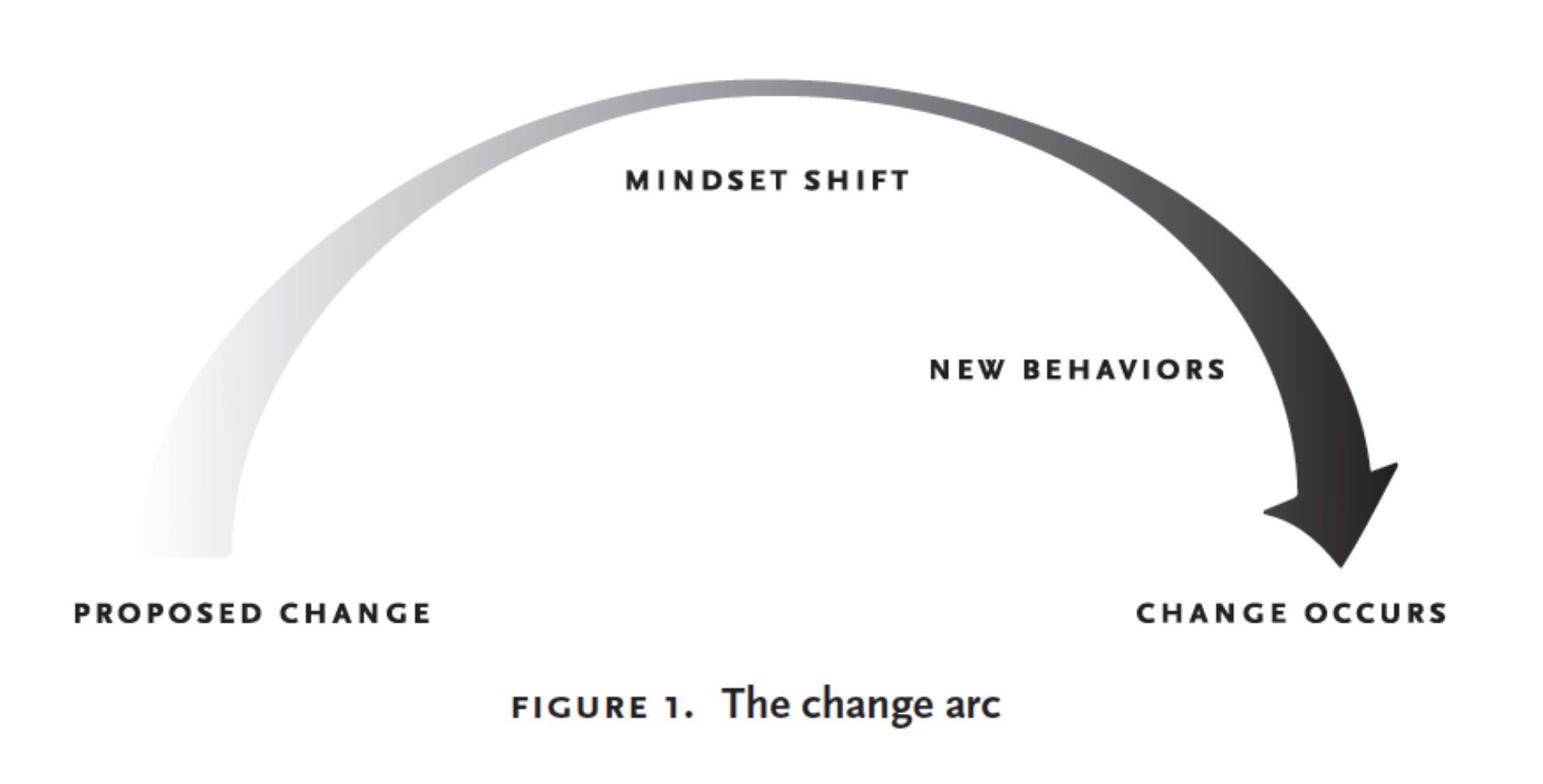
I’ve become convinced that this simple process describes the core of how all human beings move through any change, no matter how simple or complex—from having to change your dinner plans because you find your favorite restaurant is closed, to having to completely transform the business model of your company because your core product or service is no longer needed by consumers, to having to figure out how to respond appropriately to a global pandemic. Every time we make a change we need to first understand and connect with the proposed change—what it is, why it’s needed, and what it will look like when the change has been made. Then we need to make the mindset shift from seeing the change negatively (avoiding or dismissing it) to seeing it as a necessary and (ideally) positive thing. At that point we’re willing to start behaving in the new ways required by the change, so that the change can occur. This is something we can learn in both our individual lives and as organizations. And not only can our institutions change, we can institutionalize change itself so that it is becomes a part of a new sociological homeostasis. It will come from the inside out, instead of feeling as if it’s foisted upon us.
One day you’ll wake up and realize that nonstop change really has become your new normal; that you’ve stopped expecting things to “stay the same”; that you feel capable and confident to keep evolving; that you even—gasp!—may be starting to enjoy figuring out how to surf the waves of change. You feel as though you know how to accelerate your own movement through your personal change arc around new changes as they arise; you don’t feel held hostage to your own impulse toward homeostasis. You realize you can help others accelerate through their individual change arc, too—and you embrace that as an important part of being a good twenty-first century leader.
You’re becoming change-capable.
Adapted from Change from the Inside Out.
Copyright © 2021 by Erika Andersen. All rights reserved.
This book is available at all bookstores and online booksellers.
ABOUT THE AUTHOR
Erika Andersen is founding partner of Proteus, a coaching, consulting, and training firm that focuses on leader readiness. Much of her recent work has focused on organizational vision and strategy, executive coaching, and management and leadership development. In these capacities, she serves as consultant and advisor to the top executives of a number of organizations, including Spectrum, Revolt Media, Spotify, Amazon, Madison Square Garden, and the Yale School of Public Health. She is the author of four previous bestselling books, including Growing Great Employees and Be Bad First.

